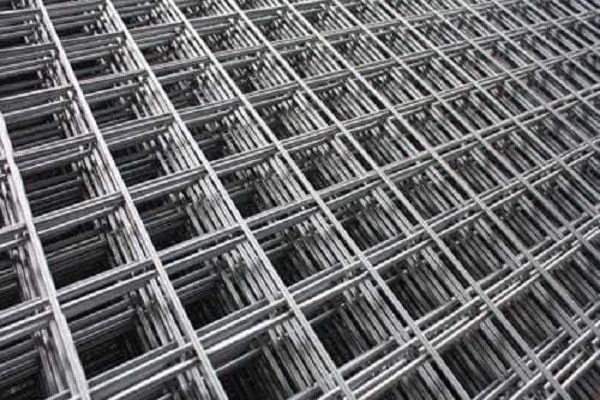The application of welded wire fabric that first comes to mind for most engineers and contractors is the reinforcement of nonstructural slabs on grade with rolls of “building fabric.” This is usually light mesh designated 6×6 W1.4xW1.4. The first pair of numbers indicates the spacing of the wires in inches. The second pair gives the size of the respective wires in cross-sectional area.
The amount of wire depends on the load on the slab, the slab thickness and the spacing of the joints. The Portland Cement Association in the publication “Concrete Floors on Ground” provides a selection chart for distributed steel that is a good guide to the designer. When longer joint spacing is desired to reduce the number of joints more steel is required. Concrete pipe manufacturers depend on welded wire fabric, either smooth or deformed wire, to meet the criteria of the industry’s ASTM standards. Its ability to delay the concrete from cracking under test loads has made it the selected reinforcement for concrete pipe of all sizes and shapes.
For concrete streets, highways and runways welded wire fabric is used in large sheets. This paving may take the form of jointed reinforced concrete pavement or continuously reinforced concrete. In jointed slabs, the reinforcement is selected based on the traditional subgrade drag theory and the amount of steel will vary based on the yield strength of the steel, the thickness of the slab, the spacing of the joints and the friction of the subgrade. Sheets as large as 13 feet by 40 feet have been used in paving projects. The amount of reinforcement in jointed slabs is relatively low, usually in the range of 0.05 to 0.20 percent. The capability of making wires at various sizes and spacings gives the designer a means to provide the exact area of steel per foot required and thus save tonnage on many high-rise projects. Another tonnage saver is the use of a higher yield strength when designing in welded wire fabric.
A large misunderstanding of the functions of fabric in preserving the life of concrete can be seen in cracked sidewalks and driveways around the country. The basic reason why a steel reinforcing material such as welded wire fabric is needed in a concrete ground slab is because concrete has little resistance to tension. By adding fabric to the slab, you add tensile strength, since steel is extremely strong in tension. Therefore, when the slab shrinks or contracts or when it is subject to the pulling, crack producing forces caused by twisting or warping, the steel resists these tensile stresses, distributing them evenly over a large area and helping it to hold tightly together minimizing cracks.
The use of the material has sometimes proved a stumbling block to contractors. Welded wire fabric is easily cut with ordinary wire cutters and may be positioned in plastic concrete in one of three ways. The first method is to place the concrete about one half the desired slab thickness, strike off, then place the reinforcement and a second course of concrete without delay so that the courses bond together completely.
A second method eliminates the need for two pours by placing piles of ready mix every three to five feet about the prepared sub-grade and then place the fabric across these piles. A variation of this is to have brickbats of the proper height placed about the sub-grade before the ready mix truck arrives.
Thorough vibration or rodding of the plastic concrete is recommended in order to be sure that the mix is distributed completely and that the fabric is properly embedded all around, so that it can best perform its function of adding tensile strength to the finished slab.
Source: concreteconstruction.net










